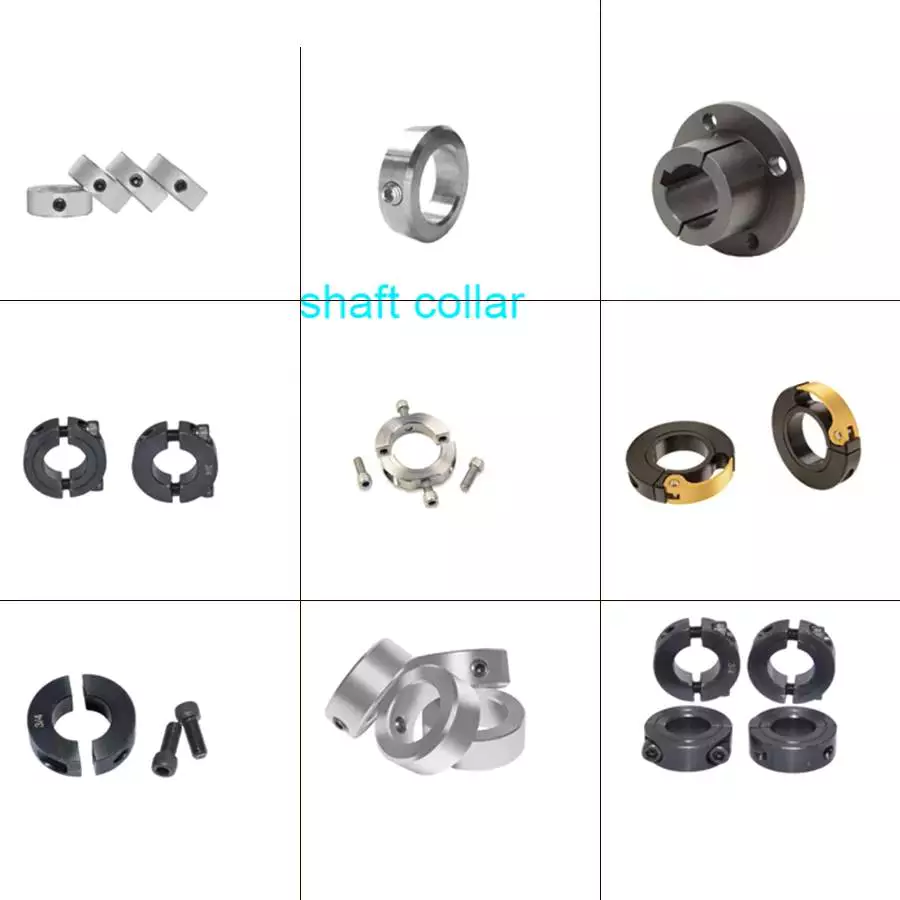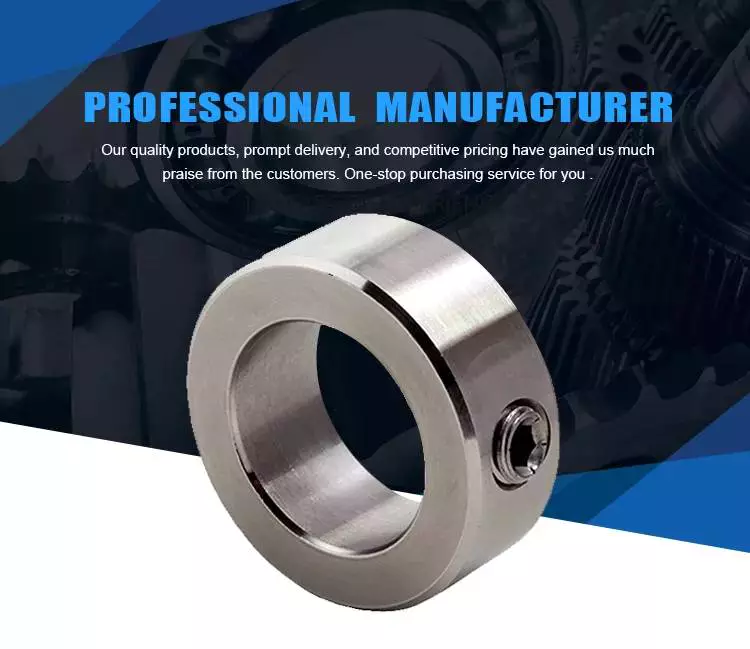Product Description
Set screw Shaft Collar, CZPT Shaft Collar, Nylon Shaft Collar, Aluminiu Shaft Collar, Single Split Shaft Collar, Double Split Shaft Collar, Shaft Coupling, Shaft Mounting Collar
Shaft collars are the most effective when used on a shaft made of a material which is softer than the set screw.
Collar Material: Steel, Stainless Steel, Brass, Aluminum, etc
Collar Finish: Zinc, Nickel, Black, Plain, etcCollar
Inner Diameter: CustomCollar
Outer Diameter: CustomCollar
Width: CustomScrew
Length: CustomScrew
Material: SteelScrew
Size: CustomScrew
Type: Socket Set Screw
Type: Solid Clamping Collar
| Application: | Machinery Accessory |
|---|---|
| Standard: | GB |
| Surface Treatment: | Anodizing |
| Production Type: | Mass Production |
| Machining Method: | CNC Machining |
| Material: | Nylon, Steel, Alloy, Aluminum |
What are the steps for retrofitting machinery with shaft collars for improved performance?
Retrofitting machinery with shaft collars can be a beneficial step to improve performance, enhance functionality, or address specific issues. Here are the general steps involved in retrofitting machinery with shaft collars:
- Assessment and Planning: Start by assessing the machinery and identifying the areas where shaft collars can be installed or upgraded to improve performance. Consider factors such as misalignment, slippage, vibration, or inadequate gripping of rotating shafts. Plan the retrofitting process by determining the number of collars required, their sizes, materials, and any additional components or modifications needed.
- Measurement and Shaft Preparation: Accurate measurement of the shaft diameter is crucial to ensure proper fitting of the collars. Use calipers or other measuring tools to determine the shaft diameter at the desired installation points. Clean the shaft surface and remove any debris or contaminants that may interfere with the collar installation. If necessary, smooth out any rough surfaces or burrs on the shaft to ensure a proper fit.
- Selection and Procurement: Select the appropriate shaft collars based on the specific requirements of your machinery. Consider factors such as shaft diameter, collar style (set screw, clamp, or other), material (steel, stainless steel, aluminum, plastic), and any special features required for improved performance. Procure the necessary shaft collars from a reliable supplier or manufacturer.
- Installation: Follow the manufacturer’s instructions for installing the shaft collars. Generally, the installation involves sliding the collar onto the shaft at the desired location and securing it in place. Set screw collars require tightening the set screws against the shaft to create a tight grip, while clamp-style collars may require tightening bolts or screws to achieve a secure fit. Ensure that the collars are properly aligned and seated on the shaft, and tighten the fasteners to the recommended torque specifications.
- Testing and Adjustment: After installing the shaft collars, conduct thorough testing to ensure their proper functionality and improved performance. Check for any signs of slippage, misalignment, or excessive vibration. If necessary, make adjustments to the collar position, tightness of the fasteners, or other factors to optimize the performance. Repeat the testing and adjustment process as needed until the desired performance improvements are achieved.
- Maintenance and Monitoring: Regularly inspect the shaft collars as part of your machinery maintenance routine. Check for signs of wear, corrosion, or any issues that may affect their performance. Lubricate the collars if required, following the manufacturer’s recommendations. Continuously monitor the performance of the retrofitted machinery to ensure that the shaft collars are functioning as intended and providing the desired improvements.
It is important to note that the specific steps and considerations for retrofitting machinery with shaft collars may vary depending on the type of machinery, the complexity of the retrofit, and other factors specific to your application. Consulting the machinery manufacturer’s guidelines, seeking expert advice, or involving professional technicians can help ensure a successful retrofitting process and optimal performance improvements.
Are there specific shaft collars designed for use in high-speed applications?
Yes, there are specific shaft collars designed for use in high-speed applications. High-speed applications require shaft collars that can withstand the rotational forces and vibrations associated with high speeds while maintaining secure and reliable shaft connections. Here are some considerations and features of shaft collars designed for high-speed applications:
- Balanced Design: Shaft collars designed for high-speed applications are often engineered with a balanced design to minimize the potential for imbalance and vibration at high rotational speeds. This helps ensure smooth operation and reduces the risk of damage to the collar, shaft, or associated components.
- High-Quality Materials: High-speed shaft collars are typically made from high-quality materials that offer excellent strength, durability, and resistance to wear. Common materials used include steel, stainless steel, or other alloys known for their mechanical properties and ability to withstand high-speed conditions.
- Precision Machining: To maintain the necessary balance and minimize potential runout, high-speed shaft collars undergo precise machining processes. This ensures that the collar has consistent dimensions, smooth surfaces, and accurate alignment for optimal performance at high speeds.
- Secure Clamping Mechanism: High-speed shaft collars often incorporate advanced clamping mechanisms to provide a secure and reliable grip on the shaft. These mechanisms, such as precision-machined set screws, high-strength clamping levers, or quick-release clamping systems, help prevent slippage or movement of the collar on the shaft during high-speed operation.
- Specialized Coatings or Treatments: Some high-speed shaft collars may feature specialized coatings or treatments to enhance their performance. For example, certain collars may have coatings that reduce friction or improve wear resistance, while others may undergo heat treatments or surface hardening processes to increase their strength and durability under high-speed conditions.
- Compliance with Standards: In some industries or applications, specific standards or regulations may exist for high-speed rotating equipment. Shaft collars designed for such applications may be manufactured to comply with these standards, ensuring that they meet the necessary performance and safety requirements for high-speed operation.
When selecting shaft collars for high-speed applications, it is important to consider factors such as the required speed range, load capacity, environmental conditions, and any specific industry or application standards. Consulting with manufacturers or industry experts can provide valuable guidance in choosing the most suitable shaft collars that meet the demands of your high-speed application.
Can I find reviews on popular brands of shaft collars for user feedback?
Yes, it is possible to find reviews on popular brands of shaft collars to gain user feedback and insights. Here are some sources where you can look for reviews:
- Online Retailers: Online retailers such as Amazon, eBay, and industrial supply websites often feature customer reviews and ratings for products, including shaft collars. You can visit the product pages of specific brands or models of shaft collars and read user reviews to get an idea of their performance, quality, and user satisfaction. These reviews are typically provided by customers who have purchased and used the products, offering valuable feedback based on their experiences.
- Industrial Forums and Communities: Online industrial forums, discussion boards, or communities dedicated to mechanical components and equipment can be a valuable resource for finding user feedback on different brands of shaft collars. Participating in these communities and posting specific inquiries about certain brands or models can help you connect with industry professionals, engineers, or users who have firsthand experience with specific shaft collar brands. They can provide insights, recommendations, and share their opinions or experiences to assist you in making an informed decision.
- Manufacturer Websites: Some manufacturers maintain customer review sections or testimonials on their websites. Visiting the websites of popular shaft collar brands and exploring their product pages or customer support sections may provide access to reviews or feedback from users who have used their specific products. Manufacturer websites often include case studies, application examples, or testimonials that can give you an idea of the performance and user satisfaction associated with their shaft collars.
- Professional Publications and Magazines: Professional publications, trade magazines, or industry-specific journals related to mechanical engineering, industrial equipment, or power transmission may feature product reviews or evaluations. These publications often conduct independent tests, assessments, or interviews with professionals in the field to provide objective insights and feedback on various products, including shaft collars. Checking these publications or their online platforms can give you access to expert opinions and evaluations.
- Social Media and Online Groups: Social media platforms like LinkedIn or Facebook may have industry-specific groups or communities where professionals and enthusiasts discuss mechanical components and equipment. Joining these groups and engaging in conversations can help you connect with individuals who can provide feedback or recommendations based on their experiences with different brands of shaft collars.
When reading reviews, it’s important to consider multiple sources and evaluate the overall consensus rather than relying solely on individual opinions. Look for patterns, common experiences, and consider the credibility of the sources providing the reviews. Keep in mind that user feedback can vary, and personal preferences or specific application requirements may influence opinions. By gathering insights from various sources, you can make a more informed decision about the popular brands of shaft collars and their suitability for your specific needs.
editor by CX 2023-12-12



